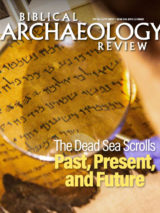Hiker Finds 2,700-Year-Old Scarab Seal
Assyrian seal discovered in Galilee
While hiking in the Lower Galilee, a man was surprised to spot a small scarab seal sparkling on the ground. Used by Near Eastern cultures for millennia, seals are important indicators of the various peoples who lived in or passed through different places. In this case, the iconography of the seal, carved in the shape of a scarab beetle, identified it as Assyrian, possibly dating back to the eighth century BCE and, therefore, suggesting the presence of Assyrians in Israel at that time.

In the free eBook, A Digger’s Life: A Guide to the Archaeology Dig Experience, step into an archaeological excavation and find out what it takes to find, prepare for, and work on a dig.
A Seal at Tel Rekhesh
Found in the Tabor Stream Nature Reserve at the foot of Tel Rekhesh, the scarab depicts a griffin and is made of carnelian. While scarab seals originated in Egypt in the fourth millenium BCE, the particular iconography of the seal is similar to Assyrian seals from the eighth century, shortly before the Neo-Assyrian Empire conquered the Northern Kingdom of Israel. It is possible the seal was a family heirloom that traveled with an Assyrian administrator to Israel after the conquest, as it was common for a son to continue using the seal of his father or grandfather.
The seal’s discovery near Tel Rekhesh is likely no coincidence, as the site boasted a large citadel in the seventh and sixth centuries, during the period of Assyrian control. The citadel included fortified structures, grand halls, ceremonial chambers, and paved bathrooms. “Considering the scarcity of finds discovered so far in the area of the citadel,” said archaeologist Yitzhak Paz of the Israel Antiquities Authority (IAA), “it may be possible to link the seal to the Assyrian presence in the citadel of Tel Rekhesh, which may be a discovery of great significance!” According to the IAA’s press release, Tel Rekhesh is an important tell site in the Galilee, identified with biblical Anacharath (Joshua 19:19) within the territory of the tribe of Issachar.
Describing his chance discovery of the seal, hiker Erez Avrahamov said, “I saw something sparkling on the ground. At first, I thought it was a bead or an orange stone. After picking it up, I noticed engravings on it resembling a scarab. I contacted and reported the amazing find to the IAA.”
Related reading in Bible History Daily
All-Access members, read more in the BAS Library
Not a BAS Library or All-Access Member yet? Join today.
This article first appeared in Bible History Daily February 2024
Must-Read Free eBooks
Want more Bible history?
Sign up to receive our email newsletter and never miss an update.
Unlock Unlimited Access to the Bible's Past
Become an All-Access Member to explore the Bible's rich history. Get Biblical Archaeology Review in print, full online access, and FREE online talks. Plus, enjoy special Travel/Study discounts. Don't miss out—begin your journey today!













